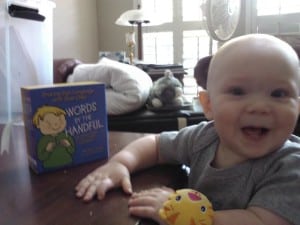What is the right age to start baby sign language? I get this question all the time. Here is the long answer below on how age and baby sign language. How old should your baby be when you start teaching baby sign language? The short answer? When YOU are ready.

Somebody please read me my favorite books! They help mommy and daddy learn signs and keep repeating them to me. And I like the pictures, too!
I use the 6 month to 2 1/2 year age range as a general rule of thumb, but rules (and thumbs) are made to be bent. Every baby is different and every family is different.
In my Words by the Handful classes, we frequently deviate from the suggested age range. I have had students as young as 5 weeks, and as old as 3 years old in my classes. While those are outliers, the trend seems to be for parents to want to start classes well in advance of 6 months old. If you want to join one of my classes and have questions and concerns beyond what is answered here, please get in touch with me!
Why Start Baby Sign Language At Six Months?
At 6 months of age, the size of a baby’s memory is getting large enough for them to begin to assimilate signs. That’s one reason why I suggest that’s a good age to start baby sign language. The uptake of signs will be a little easier for them at 6 months than earlier.
Another reason 6 months is often suggested as a starting time has to do with the return on investment/feedback loop. The earlier parents begin signing with their babies, the longer the parents will have to wait before baby begins to sign back. This is because babies need to develop a certain level of (fine and gross) motor skill to be able to make the signs with their hands. Like many things in early childhood, waiting can be frustrating and discouraging, and I’ve seen some parents give up before their kids begin to sign back. Baby sign language is a very rewarding and nurturing tool, so I encourage parents to pick the time frame that helps signing work best for them.

The sign for “deer”. (Disclaimer – this sweet newborn is too young to actually be signing, but, hey, she’s doing the sign well!)
Can I Start Signing With My Baby Earlier Than Six Months?
That said, starting to sign with your baby earlier than six months is not a problem for your baby, and it gives parents more time to get the hang of using the signs regularly. When you start earlier, by 6 months the parental signing habit can be well formed. The key to signing success is an environment where baby sees signs used, in context, and regularly and frequently.
Babies can recognize signs earlier than 6 months. Language learning – for babies and non-babies – begins with receptive language (understanding). Expressive language (speaking) follows receptive language. (And some children do sign very early on, just as some children reach other milestones on the ‘early’ end of the spectrum.)
You don’t need to wait until babies can readily sign back to begin signing with them. We don’t wait until our children can speak to begin speaking with them. Just as with spoken language, the sooner you bring signs into a baby’s life, the sooner they can start making the connections between words, signs, and the corresponding activity – the meaning.
Some working parents want to take advantage of maternity leave (3 months is typical in the US) and take baby sign language classes with their tiny babies. I’m happy to accommodate these parents (moms and dads) in Words by the Handful classes. Learning the signs early gets parents into the habit of signing, a habit that is a large part of what makes signing successful. In-home child care, as well as outside day-care, can be designed and/or identified to support signing with baby once parents return to work.
Is It Too Late To Start Baby Sign Language?
On the upper end of the age range (age 2 and over), children will likely be starting to talk or already talking. If your child is beginning to speak, but still babbling or doesn’t have a full vocabulary, signs can be a big help. Signs smoothe over the times when incomplete language is a frustration. At that age (usually above 18 months, but this varies greatly), toddlers’ ability to pick up signs is quite good. Toddlers have a larger memory and better motor skills, and they can gain quite a few signs rather quickly.
If your child is not speaking, and in the 2+ year old range, signs are especially helpful. This can be a very difficult time for children who are late talkers, and signs help smooth the frustration of not being able to communicate.
If your child is fully speaking, and you don’t have a desire to have ASL as an additional language for your child, then baby signing doesn’t make much sense. That said, use of sign language in non-deaf classrooms has been shown to boost language and learning skills for pre-K, Kinder, elementary and secondary students. It’s a brain booster.
When do babies stop signing?
When children who use signs begin to speak, they usually begin to slow or stop their use of signs in favor of speaking. Children will naturally drop the signs when they don’t need them anymore. If the parent wants the child to continue signing, the parent will need to make signing a part of the continued, natural use of language in the home.
Not quite ready to join a class? A set of Words by the Handful books is a great way to get started on your own!